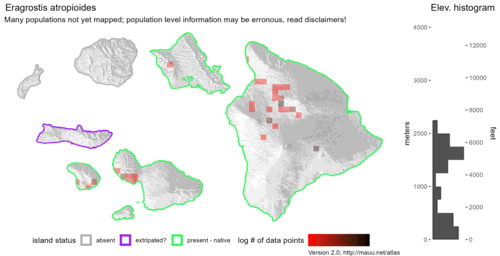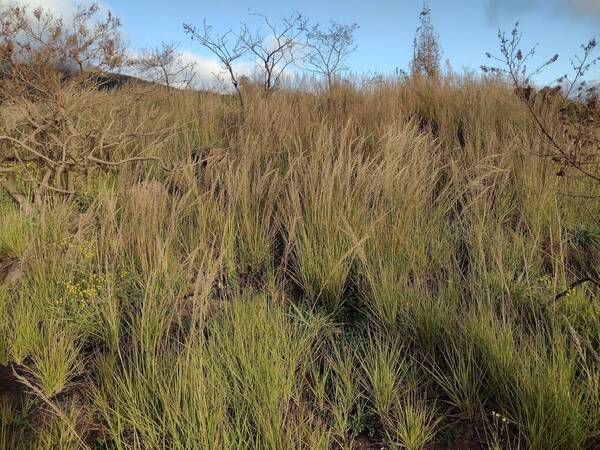Info
Subfamily: Chloridoideae
Genus etymology: Eragrostis = "love grass" [Greek] unclear origin, other etymologies such as "early grass" or "very grass" have also been speculated
Species etymology: atropioides = "resembling Atropis Rupr" [Latin] Atropis is a now defunct genus characterized by lacking keels on its florets
Photosynthetic type: C4 (warm season)
Nativity: endemic
Map


Inflorescence



Plant

Habit


Spikelets







Landscape




Collar



Rhizomes

Description
Perennials in loose tufts, with hard, scaly rhizomes up to 7 cm long; culms erect, stiff, 10-15 dm tall, glabrous, slightly scabrous below panicles. Sheaths glabrous, pilose at throat and along the margins, especially in the sterile shoots; ligule a pilose ridge, the hairs ca. 5 mm long, also with silky hairs 4- 6 mm long; blades 30-40 cm long, 4-6 mm wide, upper surface scabrous, lower surface glabrous, apex long-acuminate. Inflorescences paniculate, erect, contracted but scarcely spike-like, 25-50 cm long, 2-4 cm wide, the branches several per node, 0-10 cm long, appressed, the nodes pilose; spikelets linear, many-flowered, up to 2.5 cm long, rachilla glabrous; glumes slightly unequal, narrowly ovate, 3-4 mm long, scabrous on keel, apex acuminate; lemmas pale green or purplish green, closely imbricate, 2-3 mm long, glabrous except minutely scaberulous at apex, the apex obtuse to erose; palea persistent, 2-3 mm long, upper portion of keels ciliate, apex obtuse and usually erose. Caryopsis dark red, narrowly ovoid to fusiform, 0.7-1 mm long.
(Description source: O’Connor, P.J. 1990. Poaceae, pp. 1481–1604. In: Wagner W.L., Herbst D.R. & Sohmer S.H. (eds.)., Manual of the flowering plant of Hawaiʻi. Vol. 2. University of Hawaii Press & Bishop Museum Press, Honolulu )